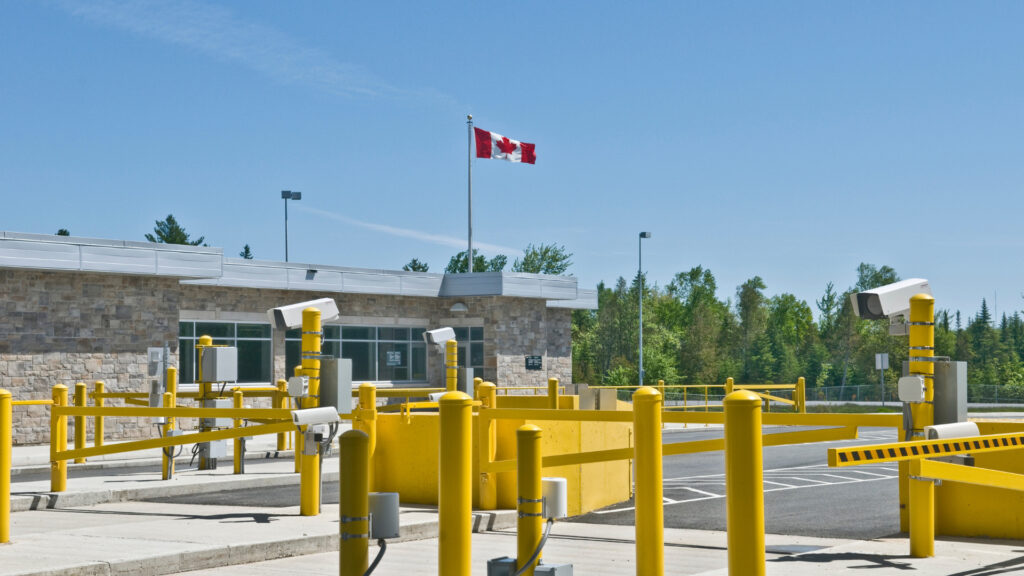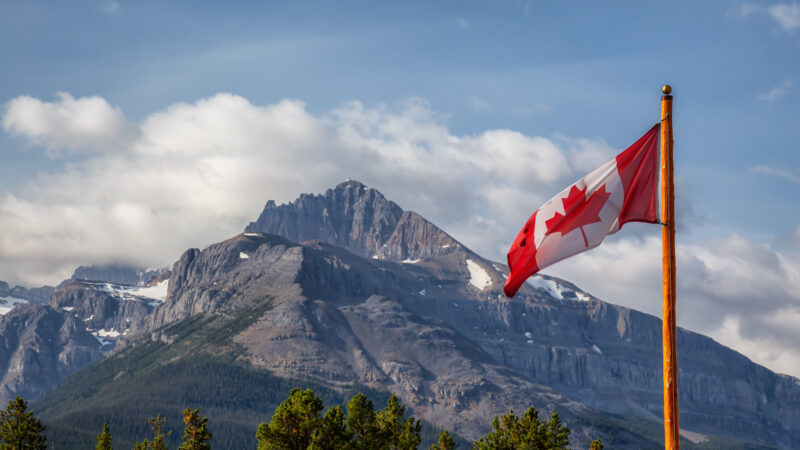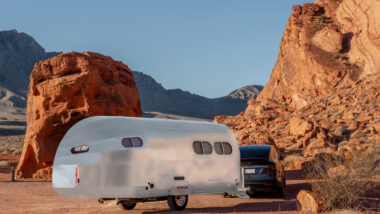Table of Contents Show
RVers have been itching to visit our neighbors to the north for the last few years. Unfortunately, crossing the Canadian border in an RV has been complicated. Thankfully, we’re happy to report that it’s gotten easier.
Don’t think you can roll up to the border with your camper and expect a smooth crossing. There are some things you need and a few things you don’t want to have when crossing the border.
Today, we’ll help you ensure you start your Canadian RVing adventures on the right foot.
Let’s get started!
Can You Cross the Canadian Border in an RV?
Crossing the Canadian border in an RV is definitely possible. Adventurers in campers have visited Banff National Park, Jasper National Park, and Prince Edward Island for decades. However, you will need to present certain documents to the officials at the border.
You need to have your ducks in a row when you pull up to the border crossing. If not, you may not get the best first impression of this beautiful country and its people.
Stay Updated on Current Rules and Regulations
If the last few years have taught us anything, it’s that the rules and regulations for visiting foreign countries can quickly change. If your travel plans involve visiting foreign countries, you should familiarize yourself with the current rules and plan accordingly.
We strongly encourage you to frequent the Government of Canada’s travel and tourism website. This website provides the most up-to-date information for those visiting the country.
Additionally, you can access any forms or resources you might need to make your border crossing as easy as possible.

What You Need for Crossing the Canadian Border in an RV
As we mentioned, there are some things you need to have in hand when crossing the Canadian border in an RV. Let’s look at what you should plan to bring with you.
Proof of Citizenship
Anyone crossing the US-Canadian border will need to show proof of their citizenship. The most common way to show this is to have a passport book or card.
If you don’t already have one, give yourself plenty of time to apply and receive it. Depending on the demand, receiving either type of passport can take several weeks.
Additionally, the NEXUS program is a joint program between the United States and Canadian governments. This is a program for low-risk travelers to cross the border with ease.
A benefit of this program is that you can get in special lanes for expedited crossings. However, everyone crossing the border in your group must participate in the program.
Additionally, residents of a few northern states on the border can apply for an Enhanced Identification Card to travel to Canada without a passport. But this only allows you to cross by land or sea. You must have a passport to fly into the country.
This Enhanced Identification Card is available to residents of Washington, Minnesota, Michigan, New York, and Vermont.
Driver’s License and Vehicle Documents
You will need your driver’s license and various documents for your vehicle. This includes a copy of your vehicle’s registration and proof of insurance. Anyone showing up to the border without these documents will likely be declined entry into Canada.
If you’re hauling a towable, have both documents for your tow vehicle and the trailer. Additionally, motorhome drivers hauling a towed vehicle must provide the documentation for that one as well.
Vet Records for Pets
Pet owners must provide a signed and dated vaccination certificate against rabies. These documents usually last one to three years but are essential for anyone wanting to bring their furry friends with them.
However, service animals are exempt from this requirement only if they accompany their owner when crossing.
Pro Tip: If you’ve never camped with dogs before, take a look at these tips to have a successful Camping trip with your furry friends!

Consent Forms for Kids
Anyone traveling with children that aren’t their own, including grandchildren, requires a consent form from the parents.
Additionally, children of divorced or separated parents will require a signed consent form from the other parent. This is simply a way of protecting children and minimizing the instances of kidnapping and trafficking.
A consent form will include the child’s name, date of birth, the names of the parents or legal guardians, the purpose of the trip, the dates of the trip, the name and contact information for those giving consent, and the signature of the parent(s) giving consent.
Having this document notarized can help ensure authenticity and avoid potential issues.
Patience
One of the biggest things you need to bring with you is your patience. Crossing any international border can be stressful. Luckily, millions of people cross the border yearly, and most do so without problems.
Be patient with the border agents and be respectful when answering their questions. Remember, crossing the border is a privilege and not a right.
You may get turned away at the border if you act like a jerk or disrespect the agents.
What Not to Bring for Crossing the Canadian Border in an RV
While you have some things you want to bring, you should leave others at home. If you don’t, you could cause a serious delay for yourself or end up in a heap of legal trouble. Let’s see what items you want to leave behind when crossing the Canadian border in an RV.

Firearms or Fireworks
Rolling up to the border with firearms or fireworks in your vehicle can land you in serious trouble.
While it is possible to bring certain firearms with you into Canada, it takes a bit of advanced planning. Individuals will need to go through a rather lengthy approval process.
Additionally, just because you have a concealed carry permit or another licensure in the United States doesn’t mean it applies in Canada. The laws regarding firearms and fireworks are very different in Canada than in the United States. Do yourself a favor, and plan accordingly.
Cannabis Products
While cannabis is legal in Canada, crossing the border with it or any CBD products is illegal. It doesn’t matter how much you have, if you have authorization for medical purposes, or if you travel from somewhere where it is also legal.
Anyone showing up to the border with cannabis products must declare them to the border agents. Unfortunately, you’ll likely lose your stash but avoid serious legal troubles if you don’t report it.
Restricted Foods
You can’t bring certain food items when crossing the Canadian border in an RV or car.
These include plants, eggs, dairy products, and fresh fruits and vegetables. If you have any of these items in your RV, you’ll want to toss them in the trash before arriving at the border.
This is a common law for many countries as it helps reduce any invasive plants, critters, or diseases that the food may carry. We recommend waiting until you cross the border to purchase groceries, so you don’t have any issues with the food you bring.

Firewood
You may dream of having a cozy campfire while RVing in Canada, but you must get wood in Canada. Crossing the border with firewood from the United States can also land you in legal trouble with border agents.
Wait until you cross the border to find a place to purchase firewood to have that cozy campfire.
Much like limiting food, the Canadian government imposes firewood restrictions to prevent the spread of insects, diseases, and other potentially damaging invasive pests.
An outbreak can have serious consequences on the plants and animals in the area.
Keep in Mind: Before you bring your own firewood camping, click the link to see why you shouldn’t
Large Amounts of Cash
Having some extra cash on hand in any foreign country, including Canada, is a good idea. However, be wise about how much you carry. If you have over $10,000 in cash, you must report it to the Canada Border Services Agency (CBSA).
We recommend depositing your cash in the bank before crossing the border. This can help you avoid filling out a CBSA Declaration Card, verbally reporting it, or using a kiosk. Save yourself the hassle and make your crossing as easy as possible.
Explore the Great White North in Your RV
Canada is one of the best places you can visit in an RV. The country offers some of the most breathtaking landscapes imaginable.
Everything from Newfoundland’s coastline to Alberta’s Rocky Mountains is worth seeing in your RV. You’ll quickly discover the majesty and novelty north of the border.
What are you waiting for? Get out and have a great time exploring Canada!







We are planning an expensive trip through Canada to Alaska this June. After reading your article, the comment about dairy products made us think about butter and cheese. Have you had any difficulty with those items. Also, we are wondering about canned and dried goods that we had planned to carry in quantity to carry us through a lot of our boondocking. Have you had any particular experience with these items. We have been calling the Canadian border and their equivalent of FDA. So far they have not returned our calls. We also raise our own meat and have our personally canned food items. Any thoughts in this area would be appreciated. Thanks!